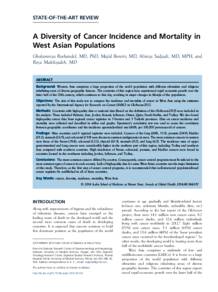Document
A Diversity of cancer incidence and mortality in west Asian populations.
Identifier
DOI: 10.1016/j.aogh.2014.09.012
Contributors
Publisher
Elsevier.
Gregorian
2014-09
Language
English
Subject
English abstract
Background Western Asia comprises a large proportion of the world population with different ethnicities and religions inhabiting areas of diverse geographic features. The countries of this region have experienced rapid economic growth over the latter half of the 20th century, which continues to this day, resulting in major changes in lifestyle of the population. Objectives The aim of this study was to compare the incidence and mortality of cancer in West Asia using the estimates reported by the International Agency for Research on Cancer (IARC) in Globocan-2012. Methods Countries with high-quality data or national data (based on the definition of the Globocan-2012) were included in the analysis. These included Bahrain, Iran, Jordan, Kuwait, Lebanon, Oman, Qatar, Saudi Arabia, and Turkey. We also found high-quality cancer data from regional cancer registries in 3 Iranian and 3 Turkish provinces. Data on cancer incidence and mortality were collected and described in tables and graphs. Spearman's correlation test was used to assess the correlation between geographic coordinates and the incidence age-standardized rate (ASR; per 100,000 person-years) of cancers. Findings Nine countries and 6 regional registries were included. Cancers of the lung (ASR, 33.3), prostate (24.9), bladder (19.1), stomach (16.5), and colorectal (15.9) were the most common malignancies in men. The most common cancers in women were those of the breast (35.4), colorectal (12.1), thyroid (10.3), stomach (9.2), and lung (6.7). The incidence rates of upper gastrointestinal and lung cancers were considerably higher in the northern part of this region, including Turkey and northern Iran compared with southern countries. High incidences of breast, colorectal, prostate, and bladder cancers were found in countries located in the northwest including Jordan, Lebanon, and Turkey. Conclusions The most common cancers differed by country. Consequently, cancer control programs must be tailored to the most common types of cancers in each country. Lack of high-quality data for some West Asian countries was the major limitation of this study. Therefore, as the first step of cancer control programs, it is recommended that well-structured population-based cancer registries be established in all of these countries.
Member of
ISSN
2214-9996
Resource URL
Category
Journal articles

